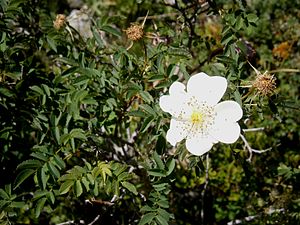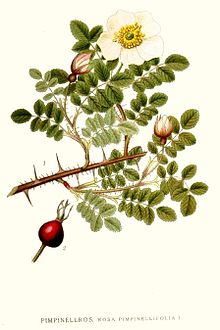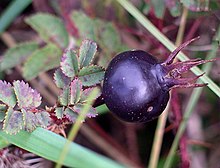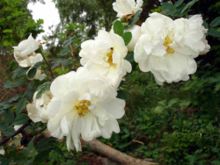Bibernell rose
| Bibernell rose | ||||||||||||
|---|---|---|---|---|---|---|---|---|---|---|---|---|

Bibernell rose ( Rosa spinosissima ) |
||||||||||||
| Systematics | ||||||||||||
|
||||||||||||
| Scientific name | ||||||||||||
| Rosa spinosissima | ||||||||||||
| L. |
The burnet rose ( Rosa spinosissima L. ; Syn .: Pink pimpinellifolia L. ), also Dünenrose , Erdrose , Feldrose , oats Rose , Prickly Rose , Empire Prickly Rose and Rock Rose called, is a plant of the genus roses ( Rosa ) within the family of the rose family (Rosaceae). It is widespread in Eurasia . The Bibernell rose is one of the oldest rose species cultivated in Europe and Asia, and the cultivated varieties also have a distinct wild character.
description

Appearance
The Bibernell rose grows as a shrub that reaches heights of 30 to 180 centimeters. The underground foothills ensure the vegetative expansion. The upright to ascending, heavily branched branches have a dark brown bark . The branches have a brownish bark and are dense and somewhat uneven with straight, rarely curved 5 to 8 millimeter long spines and coarse, pointed bristles . The flowering shoots have fewer and shorter spines than the main shoots.
leaves
The leaves are arranged alternately. The dull to dark green and bare leaves are rarely pinnate in five to mostly seven to eleven parts. The leaflets are almost circular to elliptical in shape. The leaf margin is serrate double gland. The leaf veins are barely visible. The stipules have pointed ears and only rarely do they form glandular teeth.
Flower and fruit
The flowers are solitary, but relatively dense and numerous on the short side shoots on a glandless to scattered pedunculate 1.5 to 2.5 centimeters long peduncle. The slightly fragrant, hermaphrodite flowers are four centimeters in diameter and have radial symmetry and five-fold with a double flower envelope . The five sepals have entire margins, about 1 centimeter long, and after blooming they are turned back and spread out. The five free petals have a pure white to reddish tint. The stylus stands in a very wide stylus channel and is covered by a broad, woolly scarred head . The flowering period extends from May to June.
The fruit stalk is usually longer than the spherically compressed or bottle-shaped black to purple-black rose hip .
Chromosome number
The number of chromosomes is 2n = 28.
ecology
The Bibernell rose often occurs in colonies at its locations. The colony formation is due to the many meter long root runners. As a pioneer in root creeping, the plant contributes to the consolidation of the soil with its branched runners. The deep root system represents an important adaptation to the dune location. The very small leaflets and the unusually dense spines and bristles are interpreted as weak xerophytic features.
From an ecological point of view, these are homogeneous "pollen disc flowers". The Bibernell rose is of ecological importance as a bee pasture . The rose hips serve as food for birds and small mammals .
Occurrence
The Bibernell rose is widespread in Eurasia . In Germany, the Bibernell rose occurs mainly on the North Sea coast and on the North Sea islands. Their preferred location there are the ridges of the gray dunes . It is also found inland on the silicate grasslands of central and southern Germany, the Pyrenees and the southern Alps up to altitudes of 2000 meters, but there it is relatively rare. The Bibernell rose also colonizes suitable locations in the northern Balkans.
Natural locations of the Bibernell rose are sunny bushes and forest fringes, limestone grasslands (especially on the coasts in dune sands) on dry, alkaline, shallow, stony-sandy loam soils. It is a light plant that indicates locations that are low in nitrogen. Depending on the location, it shows extreme dwarfism on rocks; if there is a lack of light, it is weak and flowerless.
The Bibernell rose occurs in dry hedges and bushes, barberry bushes (Berberidion), sloe communities and dry forests. It is also found in companies of the Calamagrostion Association. In terms of plant sociology , it is a characteristic of the association dune willow bushes (Salicetum arenariae). The dune rose bushes (Roso pimpinellifolii-Salicetum arenariae) usually populate south-facing slopes of the gray dunes. In the herbaceous layer, species of beach grass dominate. Acidophytic species in particular, such as dog violets , speedwell or field grove, are typical companions.
The Bibernell rose is often cultivated and is therefore often planted on roads and as hedges inland, which means it is occasionally naturalized. Indigenous (i.e. natural) occurrences, however, are rare inland.
protection
The Bibernell rose is often displaced by faster growing wild rose species in its ancestral locations. On some islands, for example Amrum, there are therefore initiatives that regularly debush the ecological niches of the dune rose.
Systematics
It was first published under the name Rosa spinosissima , which is valid today , in 1753 by Carl von Linné . first scientifically described. It can often be found in the literature under the name Rosa pimpinellifolia L.
Several varieties have been described:
- Rosa spinosissima var. Altaica (Willdenow) Rehd.
- Rosa spinosissima L. var. Spinosissima
- Rosa spinosissima var. Altaica (Willd.) Rehd.
- Rosa spinosissima var. Altaica-balcana hort.
- Rosa spinosissima var andrewsii Willm.
- Rosa spinosissima var. Australis Rouy
use
The dune rose is planted as an ornamental plant in gardens and parks. The Bibernell rose has been cultivated as an ornamental plant here since the 16th century . It is a variety of forms that hybridizes with other species and was used for crosses with garden roses. This resulted in many varieties with white, pink and yellow, but also with double flowers.
In landscape maintenance, it is used for embankment reinforcement ( Rosa spinosissima var. Altaica ) and recultivation.
The rose hips are very rich in vitamins and are well suited for making rose hip tea, jam, jam, jelly, juice, syrup and pastry fillings. The production of wine, schnapps and liqueur is also possible.
Varieties (selection)
- 'Double Yellow', with golden yellow petals.
- 'Single Red', with red petals.
- 'Red Nelly', with red petals.
- 'Stanwell Perpetual', breeding year 1838, with pale pink petals, often blooming.
The dune rose in literature
In her novel Inselgäste (German 2001) the Dutch writer Vonne van der Meer puts the holiday home “Dünenrose” and its guests at the center of the plot.
literature
- Klaus-Jürgen Strobel, Robert Markley: BdB Handbook Roses - "Green is Life". Pinneberg 1994.
- Heinrich Schultheis: Roses: the best types and varieties for the garden . Ulmer, Stuttgart 1996, ISBN 3-8001-6601-1 , p. 61.
- Klaus Janke, Bruno F. Kremer: Dune, Beach and Wadden Sea. Kosmos-Naturführer, Franckhsche Verlagbuchhandlung, 1988.
- Heinz Ellenberg, HE Weber, R. Düll, V. Wirth, W. Werner, D. Paulißen: Pointer values of plants in Central Europe. In: Scripta Geobotanica. 18, Verlag Erich Goltze, 1992, ISBN 3-88452-518-2 .
- Agnes Pahler: Roses: the great encyclopedia; [with 2000 varieties] . Dorling Kindersley, Starnberg 2004, ISBN 3-8310-0590-7 , page 377.
- Gu Cuizhi, Kenneth R. Robertson: Rosa : Rosa spinosissima , p. 350 - the same text online as the printed work . In: Wu Zheng-yi, Peter H. Raven (Ed.): Flora of China. Volume 9: Pittosporaceae through Connaraceae. Science Press and Missouri Botanical Garden Press, Beijing / St. Louis 2003, ISBN 1-930723-14-8 .
Individual evidence
- ↑ a b Erich Oberdorfer : Plant-sociological excursion flora for Germany and neighboring areas . With the collaboration of Angelika Schwabe and Theo Müller. 8th, heavily revised and expanded edition. Eugen Ulmer, Stuttgart (Hohenheim) 2001, ISBN 3-8001-3131-5 , pp. 571 .
Web links
- Bibernell rose. In: FloraWeb.de.
- Distribution map for Germany. In: Floraweb .
- Rosa spinosissima L. In: Info Flora , the national data and information center for Swiss flora . Retrieved November 10, 2015.
- Distribution in the northern hemisphere according to: Eric Hultén , Magnus Fries: Atlas of North European vascular plants 1986, ISBN 3-87429-263-0 .
- Thomas Meyer: Data sheet with identification key and photos at Flora-de: Flora von Deutschland (old name of the website: Flowers in Swabia )
- Inspection results HBLVA Vienna ( Memento from September 28, 2007 in the Internet Archive ) (PDF file; 1.75 MB)
- Burnet Rose - Rosa pimpinellifolia at West Highland Flora - plant identification. (English)
- Rosa spinosissima description
- Photo at Rosenfoto.de




